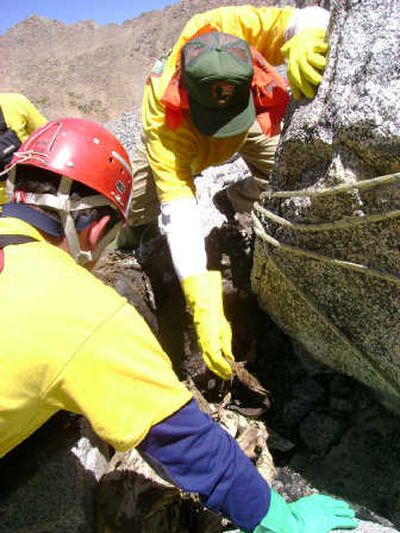Remains found on glacier

At the 13,600-foot level of Evolution Basin in California’s rugged Sierra Nevada, a Seattle author just helped write another chapter in a 65-year-old World War II mystery tied to Moscow, Idaho.
Eight days ago, author Peter Stekel notified the National Park Service that he’d found a mummified body on Mendel Glacier.
His surprise discovery came after he spent several days hiking into the remote, high-mountain area to research his forthcoming book on four World War II airmen who disappeared on Nov. 18, 1942, when their AT-7 Navigator crashed in a snowstorm near the California-Nevada border.
Their bodies and most of the aircraft wreckage became encased in the Mendel Glacier, and only fragments of evidence were recovered immediately after the crash.
Stekel became part of the book he’s writing because severe drought conditions are shrinking the glacier. Now, the Seattle author, who’s still in the backcountry and unavailable for comment, is likely eager to know the identity of the body he discovered.
John M. Mortenson, 25, of Moscow, and Ernest G. Munn, 23, of Clairsville, Ohio, were two of three U.S. Army Air Forces aviation cadets aboard the training plane piloted by 2nd Lt. William A. Gamber, 23, of Fayette, Ohio.
The body found by Stekel is believed to be one of those three men, according to the National Park Service and military forensic experts.
The remains, including an unopened Army parachute, were recovered from the glacier on Monday by helicopter, three days after the author hiked to a remote ranger station and reported the discovery on Aug. 18, said Deb Schweizer, National Park Service public information officer, who is stationed at Kings Canyon National Park.
Before the removal, a park service anthropologist photographed and documented the scene. The area was searched for further evidence without results.
No positive identification was made this week during a preliminary examination by the Fresco County coroner before the body was turned over to U.S. military forensic experts.
The initial exam turned up a 1923 buffalo head nickel, a decaying wallet with faded photographs and an ice-preserved Army Air Forces uniform of World War II vintage, authorities said.
The remains are scheduled to be flown today from Travis Air Force Base in California to the Joint POW/MIA Accounting Command’s forensic laboratory at Hickam Air Force Base in Oahu, Hawaii.
Identification of the body is expected to take a month or two, said Troy Kitch, deputy director of public affairs at JPAC, the world’s largest forensic identification lab.
Military forensic anthropologists will attempt to obtain a DNA sample from the corpse and send that sample to the Armed Force’s DNA laboratory in Maryland where its unique coding profile will be developed. That DNA profile will then be returned to the JPAC Central Identification Laboratory in Hawaii for the comparison analysis.
Military experts who travel the world recovering and identifying U.S. war casualties are hopeful because of the condition of the body that a good DNA sample will be obtained, Kitch said.
Mortenson, whose birth name was Melvin J. Mortenson, was the son of John and Ida Mortenson, who lived at 824 E. Seventh in Moscow, according to files compiled by the Family History Center of the Church of Jesus Christ of Latter-day Saints.
Both his parents died and were buried in the Moscow City Cemetery before Mortenson enlisted in the U.S. Army Air Forces, hoping to become an aviator, using the name John M. Mortenson. He had two sisters who moved to Seattle and never married after he disappeared. A plaque honoring “Melvin Mortenson” and other Moscow soldiers killed during World War II hangs in Moscow High School.
Stekel was researching his forthcoming book, “Final Flight,” about the 2005 discovery of the first body found by two ice climbers, just 100 feet away, and later positively identified as that of aviation cadet Leo A. Mustonen, 22, of Brainerd, Minn.
After that discovery, military researchers obtained mitochondrial DNA samples from living relatives of Mortenson, Munn and Gamber, Kitch said.
David Berry, a forensic historian in Dayton, Ohio, who does consulting work for the military, said Friday it took him three days to locate Mortenson’s 95-year-old sister, his only living survivor, who provided a DNA sample. It couldn’t be determined Friday if that sister, who lives in Washington, is still alive.
Mustonen had no living survivors, and hisidentity was determined through the process of elimination and microscopic examination of a unique name tag aviation cadets wore.
With those DNA samples from 2005 already in the data base at the JPAC forensic lab, it should be easier to determine if the latest body is, in fact, one of the four missing airmen.
The twin-engine training aircraft carrying the four men took off from Sacramento and apparently was well off course when it crashed into the towering Sierra Nevada range on the California-Nevada border, east of Fresno, according to military historians.
None of the bodies was found immediately after the crash, and the wreckage wasn’t located until 1947, Schweizer, said Friday.
Only pieces of flesh were found by military recovery teams in that year, and they were interred in a common grave in Golden Gate National Cemetery in San Francisco on Oct. 15, 1948.
Stekel had obtained a backcountry permit and spent two or three days hiking to the remote site this month.
The Mendel Glacier and adjoining Darwin Glacier, which straddle “Evolution Basin” in the national park, have significantly melted because of an on-going California drought, Schweizer said. Last winter’s snowpack in the Sierra Nevada was only 25 percent of normal.